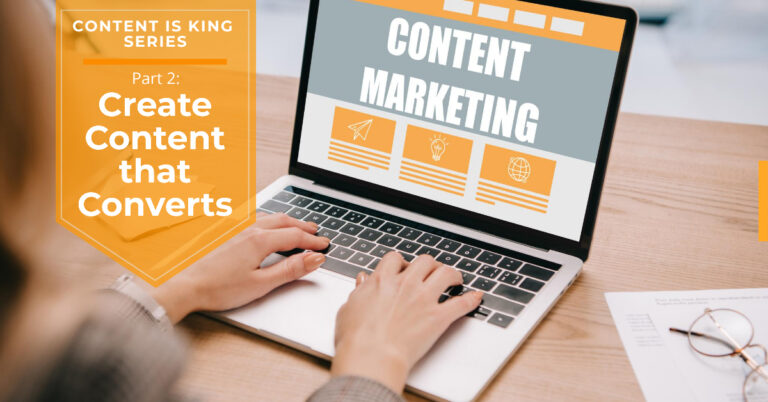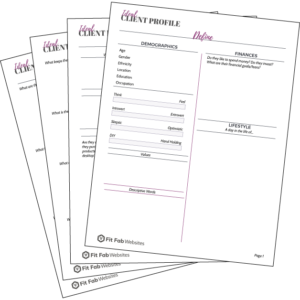Menu
Menu
No products in the cart.

There is only one reason someone would read your content (family and friends excluded) and that is to answer a question. Maybe it’s to a question they already had or maybe it’s to a question you sparked in their mind. Either way, good content answers a question.
Now that question could be something that they've already thought about or maybe they are curious about, but either way they are trying to find an answer. Your mission, if you choose to accept it, is to write content that is relevant to your ideal client.
I cannot stress enough how important it is to create an ideal client profile and I'm not alone. Marketing Geniuses such as Neil Patel, Seth Godin, and David Ogilvy always talk about how important it is to understand the client first. In my experience working with many companies over the last 20 years, the companies that were the most successful are the ones that had a solid marketing plan that included an ideal client profile.
There are many different templates available to create your ideal client profile but all effective ideal client profiles have several things in common:
The best way to do this is to look at where your preferred clients are (the clients you are already working with). Are they on social media? If so, which ones. If you don’t already know how they found out about you, then you need to ask them.
What are the things your ideal client stays up late at night thinking about? What are the things in their life that make things difficult? Chances are, you are your ideal client (or you were), so take some time to really think about what life is like in their shoes.
Once you know what problems your clients have, then it’s time to think about how your offer helps them. Will it make their life easier? How?
This is the part that most small businesses don’t do. They create one client profile and then they think they’re done.
Have you ever done something perfectly on the first try? I haven’t and most people don’t. It will take multiple iterations to get your ideal client profile nailed down. Until you create content, measure the effectiveness, and adapt, chances are you may not have an effective ideal client profile created.
By creating more than one profile and creating content for each of them, you’ll figure out which is the more effective one. Otherwise, you may spend countless hours creating content without getting the results you think you should. With more than one client profile, you’ll be able to see which messaging lands the best.

This is probably the biggest mistake that content creators make. They don't take the time to identify which part of the sales funnel they are creating content for. When you think about the purchasing timeline for anybody, there are four main phases that need to be identified before starting to create content.
Eugene Schwartz brilliantly categorized the phases of customers in his book he wrote in 1966 “Breakthrough Advertising.” Before you create your content, think about which phase your ideal client is first.
They know they have something about their life that makes them unhappy, but they don’t actually know what the problem is. For example, someone knows that they need to eat healthy, get sleep, and breathe more (haven’t we all heard these messages 1,000 times?) because if they do, they will be a happier person. But, they don’t realize the problem is that they don’t have an easy to follow strategy in place.
They are aware of the problem but they do not know the solutions available. For example, they know they need a strategy in place to start living a healthier life, but they aren’t sure what kind of program would even work for them.
They know what the problem is, they know there are solutions available, but they don’t know that you have an offer that helps them. For example, they know they need a strategy, they know that they want a group program that fits their budget, but they don’t know anything about your offer.
They know what the problem is, they know there are solutions available, and they have identified a specific product as a solution, but they are not sure whether it is right for them because their questions about the offer have not been answered yet. For example, they know they need a strategy, they know that they want a group program that fits their budget, they know about your offer, but they still have doubts whether your offer is going to help them.
They are your long time followers. They read your content, but they are still on the fence and haven’t made the decision to become a client or customer. They’re waiting for the right time or the right counter argument to the doubts they have.
In a perfect (marketing) world, you obtain detailed information from 2,000 people in a questionnaire or conduct targeted focus groups. But chances are that is not a possibility for you at the moment. Luckily, there are ways you can collect research from your ideal clients that are free and easy.
When you created your ideal client profile (you’ve done that already, right?), you identified where your ideal clients are. Most people will have some form of social media on their list, and that’s where you need to go.
Read what they are posting about, what they are commenting on. What kind of questions are they asking? Your ideal clients are looking for answers to their questions, and you have the opportunity to provide the content for them.
Whether you have a big following or not, take a poll or ask a question to your followers. When it’s a relevant question, they’ll answer. If you don’t get much of a response, then that may not be relevant or you may have asked at the wrong time. Test and try again.
Ever hear of the 80/20 rule? Well, when it comes to writing, 80% of your time should be done researching and 20% writing. Understanding your clients and their needs will make writing content much easier.
If you are writing content for a blog or website, doing keyword research is an important step, so don’t skip it. From Google Keyword to Ubersuggest and Brand Overflow, there are lots of tools available to do keyword research. And there are also great tutorials that show you how to do your own keyword research.
Some tutorials that I have found helpful in learning how to do keyword research:
How to do Keyword Research - Neil Patel
How to do Keyword Research - HubSpot
This may be the last step but it is the reason you should write content (unless you’re writing content for fun but if you are, you’re probably not reading this). No matter who your ideal client is, where they are consuming their content, or where they are in the sales process, your content should provide value.
If you write content that answers the questions your readers have, you will be viewed as an authority and they will trust that what you write provides useful information. Your content will provide a way for your reader to like, know and trust you.
When you combine the information from your client profile, know which stage you are writing for, have done your own research and know what questions your ideal clients have, writing becomes easier. You’ll have everything you need to answer your ideal clients' questions and help them solve their problems through your content and ultimately through your offer.
